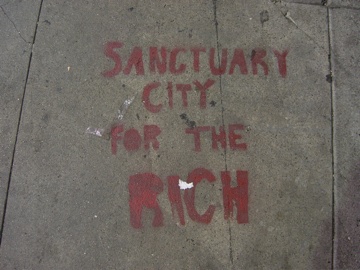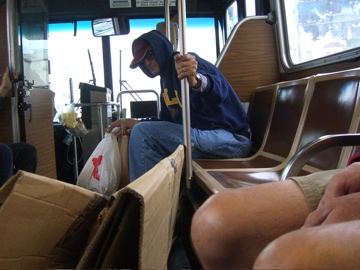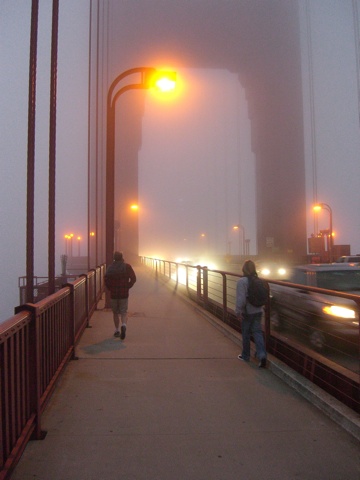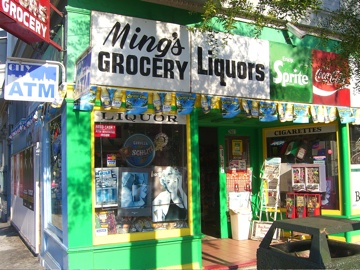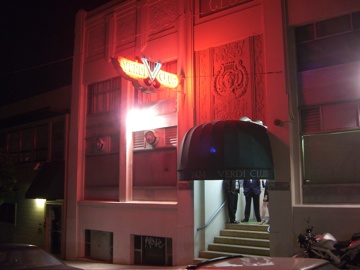After we got done with our two little afternoon newscasts at KQED yesterday, and after I had cleared a couple stories for this morning that had been awaiting edit, I walked up to the Safeway a couple blocks away, at 16th and Bryant streets. There’s a big shopping center there that runs a full city block over to the east, to Potrero Avenue. Before the center was there, the site was occupied by a giant car dealership. Before the dealership, it was home to Seals Stadium, where the city’s Triple A baseball team played until they were kicked out when the Giants arrived in 1958.
The shopping center has a huge double-deck parking garage. The upper lot is above street level along 16th, so there’s a wall that runs, at varying heights because the street slopes, the entire block between Potrero and Bryant. Last night when I got to 16th and Bryant, there was a man lying at the base of the wall, a few feet from a bus stop at the corner.
You encounter people lying on the street in San Francisco every day. So many people have plunged through whatever gave their lives structure and support that they’ve become part of the landscape. Every once in a while, one will attract particular attention: because they’re particularly abject, because they’re acting out in some outrageous way, or because there’s something in their physical attitude that makes you wonder whether they’re still breathing.
The guy I spotted at the base of the wall last night was in the third category. He was lying on his side with his back to the wall and a blue-jean jacket pulled over his head. He wasn’t moving. He was wearing dirty jeans and some beat-looking hiking boots. I stood over him for a few seconds to see if I could see him breathing. I thought he was, but wasn’t sure. Then I walked up into the upper level of the parking lot and stood above him and decided to call 911. Since I was on a cellphone, I got routed to the California Highway Patrol; the delay was long enough that I changed my mind about the emergency call. I hung up, then called information for the number of the Mobile Assistance Patrol. MAP started back in the ’80s, I think, when the city’s homeless population first spiked and emergency services found themselves swamped with calls for destitute people unconscious on the streets.
I called MAP and got an operator and described the situation. “OK. Is he breathing?” she asked. “Yes.” “Do you think he’s intoxicated?” “Well, yeah, that’s the usual situation, right?” I said. “OK …”
At that moment, the figure on the sidewalk below me came to life. The man–he was white, middle aged, unshaven, close-cropped brown hair–said, “I’m fine. I don’t need anyone to come help me.” I was relieved, told the operator the guy was still among the living, and hung up. The man put his head back under his jacket, and I walked over to the grocery store.
My errand was to buy a couple cheap Safeway sandwiches for me and one of the reporters back at the station. I bought one for the guy lying on the sidewalk and got him one of those protein smoothies, too. When I got back to the street, he was still lying there. “I know you heard me when I made that phone call before,” I said. “I don’t want to bother you, but I’m going to leave a sandwich and something to drink right here.” He pulled the coat off his head and tried to sit up. “Thank you, thank you, I need that,” he said. I gave him a hand so he could sit upright against the wall. He thanked me again and told me his name, Charles McCue. He was disheveled and dirty but not drunk or drug-addled at the moment. I told him my name, and I asked him how long he’d been out there. “Three years on the street,” he said. He looked up and down 16th. “I used to … I don’t know how I got here.”
I asked him about his family name, thinking it might have come from Ireland. “Where are you from?”
“I’ve lived here for twenty-six years!” he said. “I’ve … I was the director of the San Francisco Shakespeare Festival.” The festival is a well-known company that has put on free plays in parks since the early ’80s. If this guy had been the director–well, he had had things together at some point and really–desperately–lost his way.
“Shakespeare? ‘Midsummer Night’s Dream’? ‘Richard the Second’?”
“Oh, I can give you all thirty-eight of them if you have time,” he said. ” ‘All the world’s a stage, and all the men and women merely players: They have their exits and their entrances. …’ ”
He trailed off. I asked him where he stayed at night. “On the street,” he said. But where–any particular place, or wherever he found himself? “Wherever I find myself,” he said. “I was so tired that I just sort of collapsed here.” He had nothing with him but what he was wearing.
I had to leave, and I told him to eat. “Have a good night,” I said. “I’m sorry, I don’t mean that ironically. I’ll look out for you when I’m in the neighborhood.”
I walked back to the office, and when the work of the shift was done, I looked up Charles online. There he was. He’d been involved with the company from its inception through 2003. I found an item from July 2003 that described his departure:
A farewell to the Bard: Just as the San Francisco Shakespeare Festival prepares to open its 21st Free Shakespeare in the Parks season with “Love’s Labour’s Lost,” it’s lost one of its primary laborers. Producing Artistic Director Charles McCue , the company’s leader since ’97 — and a member since its first season — has quietly tendered his resignation.
The reasons were not artistic but personal, festival members said (McCue was not reachable at press time). After setting the schedule and hiring Ken Kelleher to direct the summer show, McCue took a brief leave, then decided to make it permanent. With the summer opening on hand, the board of directors named managing director Toby Leavitt the executive director for now.
I wrote Rob an email about my encounter with the man on the street. He said he really didn’t know what had become of Charles McCue and suggested that his successor at the festival might.
After work, I walked back up to the corner where I’d found Charles. He was gone, and he wasn’t one of the dozen or so homeless men that I saw in the walk down to the 16th Street BART station.
Technorati Tags: homeless, san francisco

